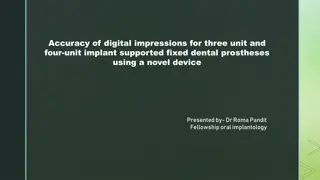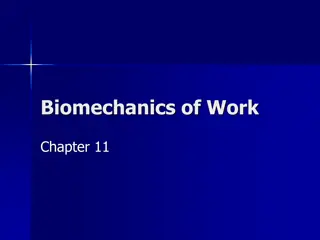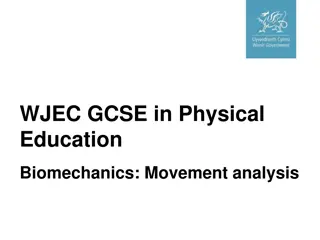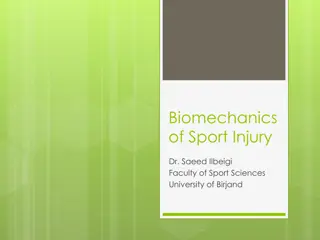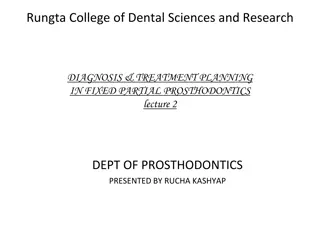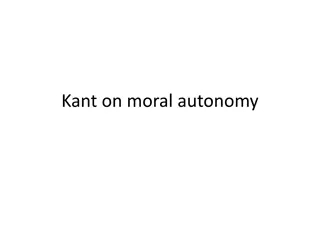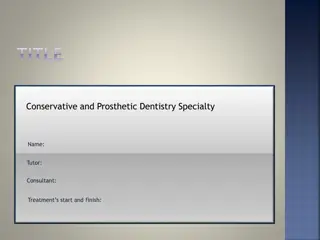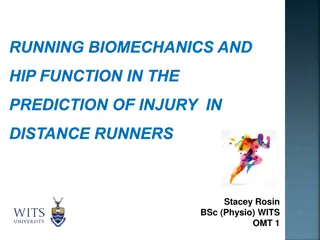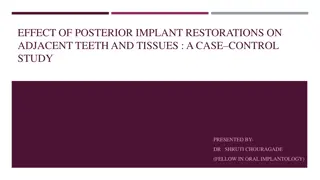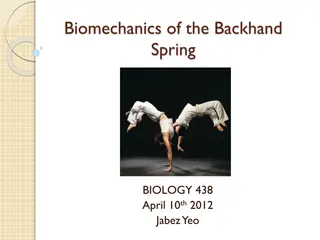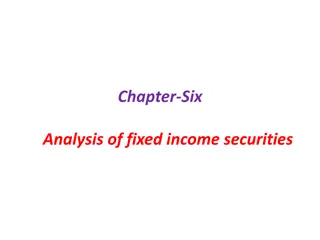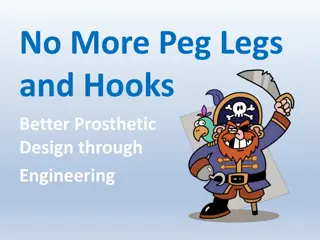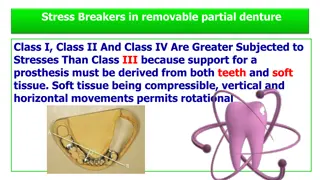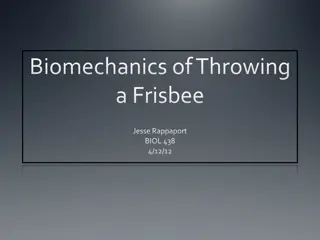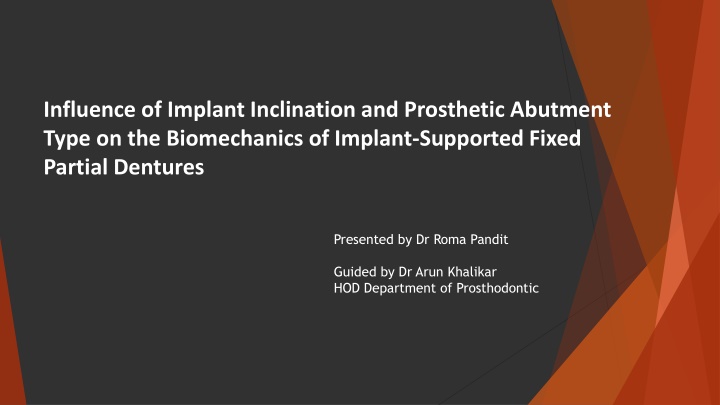
Implant Inclination Influence on Biomechanics of Fixed Dentures
Explore the impact of implant inclination and abutment type on the biomechanics of implant-supported fixed partial dentures, highlighting the challenges and solutions in achieving optimal outcomes. This study discusses the critical role of implant alignment and prosthetic abutment selection in maintaining stability and reducing potential risks associated with implant-supported rehabilitations.
Download Presentation

Please find below an Image/Link to download the presentation.
The content on the website is provided AS IS for your information and personal use only. It may not be sold, licensed, or shared on other websites without obtaining consent from the author. If you encounter any issues during the download, it is possible that the publisher has removed the file from their server.
You are allowed to download the files provided on this website for personal or commercial use, subject to the condition that they are used lawfully. All files are the property of their respective owners.
The content on the website is provided AS IS for your information and personal use only. It may not be sold, licensed, or shared on other websites without obtaining consent from the author.
E N D
Presentation Transcript
Influence of Implant Inclination and Prosthetic Abutment Type on the Biomechanics of Implant-Supported Fixed Partial Dentures Presented by Dr Roma Pandit Guided by Dr Arun Khalikar HOD Department of Prosthodontic
Author Victo rio Poletto-Neto, DDs, MSc1 , Pedro Henrique Wentz Tretto, DDS, MSc2, Bruno Massucato Zen, DDS, MSc3, Ata s Bacchi, DDS, PhD2, Mateus Bertolini Fernandes dos Santos, DDS, PhD1* Source Journal of Oral Implantology
Introduction: Implant-supported rehabilitations are considered the best treatment option for fully or partial edentulous patients, presenting favorable rates regarding success of implants and prostheses in all kinds of rehabilitations (ie, full-arch fixed prostheses, fixed partial dentures, single crowns, and overdentures). When planning a rehabilitation, it is generally recommended that multiple implants should be placed parallel to each other, to better distribute occlusal stresses at the implant level, for subsequent dissipation of this stress within peri-implant bone tissue, and to facilitate abutment selection. However, during surgical procedures, this parallelism is often hard to achieve because of possible intercurrences and local factors (mouth opening, bone quality, etc) as well as operator skills (nonguided surgeries). Although implant inclination may often be seen in clinical practice, cases presenting excessive inclination can still be corrected by using several types of abutments; the most used are the universal castable long abutment (UCLA) and the angled tapered abutment.
These abutments may correct the screw hole position but do not alter the position of the implants that support the prosthesis, which could have a critical biomechanical behavior. Such situations could generate higher stresses within the prosthetic screws, implants, and peri-implant bone tissue, which might lead to increased marginal bone loss and prosthetic complications.
MATERIALS AND METHODS: Three-dimensional (3D) models were obtained using 3D modeling software (SolidWorks 2016, SolidWorks Corp, Concord, Mass) representing a clinical situation considered prevalent in implant-supported rehabilitations. The model considered a posterior mandibular section with a fixed partial denture supported by 2 implants, distancing 16 mm between its centers. Mandibular geometry was modeled from a computed tomography image; the implants were based on Mark III external hex (Nobel Biocare) presenting a 4.1-mm platform with 3.75- 3 11.5- mm dimensions. Two variables were assessed in this study: the inclination of 17 degree of one of the implants in different directions (mesial, distal, buccal, and lingual) and the type of prosthetic abutment (customized UCLA or tapered abutment). Parallel implants were considered as control groups for both types of prosthetic abutment.
All materials were considered linearly elastic, homogeneous, and isotropic. The finite element meshes were defined by tetrahedral elements, characterized by triangular base pyramids, with one node at each vertex and another at the center of each edge, totaling 10 nodes per element.
The analyses were performed using the mechanical simulation software ANSYS Workbench 16. With regard to the boundary conditions, the base of the mandible was considered the fixed point, and forces were applied to the functional cusps of the 3 prosthetic crowns. The force vector applied was composed by 110 N vertical and 15 N horizontal. Results were analyzed by qualitative evaluation through figures and color gradients according to the stress concentration in each region and quantitative analysis by means of numerical reading of the stress in certain nodes of the mesh. All analyses were performed considering the maximum and minimum principal and von Mises stresses (in MPa).
RESULTS: Parallel positioned implants presented similar stress values in the prosthesis, regardless of the abutment used. However, when the anterior implant was tilted 17 degree, the stresses generated by UCLA in the prosthetic framework were higher in comparison with tapered abutments tilted to mesial, lingual, and distal. When the anterior abutment was angled to the buccal direction, prosthetic frameworks made with UCLA abutments presented lower values of stress than tapered Abutments
The von Mises stress values in the screw that connects the tapered abutment to the anterior implant was relevantly higher to that found with UCLA. On the other hand, the values generated in the same prosthetic screw on the posterior implant were reduced approximately 50% in comparison with the use of UCLA.
The prosthetic screw of the anterior tapered abutment presented a relevant increase in stress values when implants were tilted. This increase of stress was not observed in the posterior abutment screws. Stresses in the anterior tapered abutment were relevantly higher when the implant was tilted, except in the distal inclination group. The inclination of the anterior abutment did not influence the stress in the posterior one. The stress values in the anterior implant increased relevantly only when it was tilted buccally. The use of UCLA caused higher stresses values when distal and lingual inclinations were assessed. No relevant differences were found in the stresses in the posterior implant. Bone tissue maximum principal stress values ranged from 8 to 6 MPa and from 0.5 to 0.8 MPa for minimum principal stress among studied groups and no relevant differences were recorded in the variations in abutments or implant inclinations.
CONCLUSION: The UCLA and tapered abutments can be indicated for 3-unit implant-supported fixed partial dentures. However, when one of the implants present an unfavorable inclination, the use of angled tapered abutments could be beneficial because of the reduction of stress in the prosthetic screws, preventing their loosening over time.


